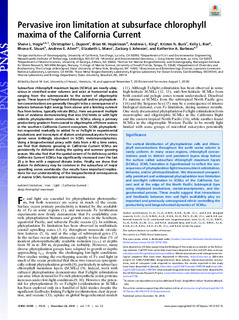| dc.contributor.author | Hogle, Shane L | |
| dc.contributor.author | Dupont, Christopher L | |
| dc.contributor.author | Hopkinson, Brian M | |
| dc.contributor.author | King, Andrew L | |
| dc.contributor.author | Buck, Kristen N | |
| dc.contributor.author | Roe, Kelly L | |
| dc.contributor.author | Stuart, Rhona K | |
| dc.contributor.author | Allen, Andrew E | |
| dc.contributor.author | Mann, Elizabeth L | |
| dc.contributor.author | Johnson, Zackary I | |
| dc.contributor.author | Barbeau, Katherine A | |
| dc.date.accessioned | 2019-05-14T12:04:47Z | |
| dc.date.available | 2019-05-14T12:04:47Z | |
| dc.date.created | 2019-03-14T12:40:12Z | |
| dc.date.issued | 2018 | |
| dc.identifier.citation | Proceedings of the National Academy of Sciences of the United States of America. 2018, 115 (52), 13300-13305. | nb_NO |
| dc.identifier.issn | 0027-8424 | |
| dc.identifier.uri | http://hdl.handle.net/11250/2597579 | |
| dc.description.abstract | Subsurface chlorophyll maximum layers (SCMLs) are nearly ubiquitous in stratified water columns and exist at horizontal scales ranging from the submesoscale to the extent of oligotrophic gyres. These layers of heightened chlorophyll and/or phytoplankton concentrations are generally thought to be a consequence of a balance between light energy from above and a limiting nutrient flux from below, typically nitrate (NO3). Here we present multiple lines of evidence demonstrating that iron (Fe) limits or with light colimits phytoplankton communities in SCMLs along a primary productivity gradient from coastal to oligotrophic offshore waters in the southern California Current ecosystem. SCML phytoplankton responded markedly to added Fe or Fe/light in experimental incubations and transcripts of diatom and picoeukaryote Fe stress genes were strikingly abundant in SCML metatranscriptomes. Using a biogeochemical proxy with data from a 40-y time series, we find that diatoms growing in California Current SCMLs are persistently Fe deficient during the spring and summer growing season.We also find that the spatial extent of Fe deficiency within California Current SCMLs has significantly increased over the last 25 y in line with a regional climate index. Finally, we show that diatom Fe deficiency may be common in the subsurface of major upwelling zones worldwide. Our results have important implications for our understanding of the biogeochemical consequences of marine SCML formation and maintenance. | nb_NO |
| dc.language.iso | eng | nb_NO |
| dc.publisher | National Academy of Sciences | nb_NO |
| dc.rights | Attribution-NonCommercial-NoDerivatives 4.0 Internasjonal | * |
| dc.rights.uri | http://creativecommons.org/licenses/by-nc-nd/4.0/deed.no | * |
| dc.title | Pervasive iron limitation at subsurface chlorophyll maxima of the California Current | nb_NO |
| dc.type | Journal article | nb_NO |
| dc.type | Peer reviewed | nb_NO |
| dc.description.version | publishedVersion | nb_NO |
| dc.source.pagenumber | 13300-13305 | nb_NO |
| dc.source.volume | 115 | nb_NO |
| dc.source.journal | Proceedings of the National Academy of Sciences of the United States of America | nb_NO |
| dc.source.issue | 52 | nb_NO |
| dc.identifier.doi | 10.1073/pnas.1813192115 | |
| dc.identifier.cristin | 1684772 | |
| cristin.unitcode | 7464,20,14,0 | |
| cristin.unitname | Marin biogeokjemi og oseanografi | |
| cristin.ispublished | true | |
| cristin.fulltext | original | |
| cristin.qualitycode | 2 | |

